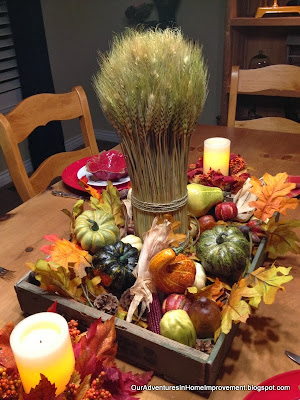Monday, October 28, 2013
Your New Bathroom Suite – Essential Items
Sunday, October 27, 2013
From Back Porch to Fab Mud Room Part 1--The Pantry




Thursday, October 24, 2013
Portable Heating: Fan vs. Oil
As the cold winter nights start rolling in, now is the best time to get your home ready for the arrival of Jack Frost!
Central heating is often the best solution for heating your home throughout the winter months, but if your home is not fitted with a permanent central heating source or you have certain rooms in the home that are difficult to heat, it may be worth investing in a portable heater to keep your family warm this winter.
With so many different types of portable heaters on the market, it can be difficult to decide which will not only heat your home the most efficiently, but also which will make the smallest increase to your heating and electricity bills. With heating the home accounting for more than 50% of the average household energy usage, choosing the best portable heating solution for your home is essential.
We’re taking a look at the pros and cons of fan heaters VS oil heaters, the two most common portable heaters available on the market. Ranging in price, both heaters are ideal for warming up the home quickly, but how do they compare?
Oil Filled Heaters
Pros
• Oil-filled heaters are usually the cheapest to run out of all ranges of portable heaters, as they stay warm for a long time, even once switched off.
• They generally have a larger surface area, so they are ideal for heating larger rooms in the home.
• Oil-filled radiators are reliable heat sources, quiet in the home and most importantly are long lasting.
Cons
• Oil radiators reach extremely high temperatures, therefore they can be dangerous if you have children in your home, and could cause great harm.
• Some oil-filled heaters can take a very long time to heat up after switching them on, as most are fairly heavy and cumbersome.
• Many models don’t always achieve the power and heat claimed by manufacturers; therefore you might not get the heating power you expect for your home.
Average Cost per Hour
• Oil-filled radiator = 12.2p per hour (Price varies by wattage and electricity prices)
Fan Heaters
Pros
• Fan heaters are relatively quick to heat up and cool down, which makes them perfect for smaller rooms in the home.
• Fan heaters have the added advantage that they blow the heat around the room, which means heat circulation is aided and the air in the room can heat up quickly.
• Fan heaters are light and compact, making it easy to move them from room to room if necessary.
• Many fan heaters have a thermostat and timer, which allows you to adjust the temperature and length of time the heater, is circulating hot air in your home.
• Fan heaters are the best choice for home owners with children as hot air can move freely in and out of the heater – therefor the heater itself does not get too hot.
Cons
• Given that portable electric heating devices use electricity, they are generally not as cost effective as central heating systems running on gas or oil.
• Fan heaters are guaranteed to make noise as the hot air in blown out – the noise level will vary with different fan heaters.
Average Cost per Hour
• Fan heater = 24.2p per hour (Price varies by wattage and electricity prices)7
Online discount store www.tjhughes.co.uk stock a wide range of portable heaters starting from only £7.99 - shop online today or visit one of their nationwide stores.
8 Basic Property Updates to Address Regularly
Today I have Tali Wee of Zillow sharing an article on 8 Basic Property Updates to Address Regularly. She has some great ideas listed here!
Thanks Tali!
Tuesday, October 22, 2013
Extend Your Home Rather Than Move
Seems like this recession (depression feels like a better word) has been dragging on for years. But we still have our lives to live, our families to raise and our dreams and ambitions to fulfil - whatever the prevailing economic weather.
One of the obstacles that many us of face in the current climate is what to do when we run out of space in our homes. A few years ago the answer was simple - you moved house. These days with a difficult housing market it can be very difficult to sell your existing house and even more difficult to get a bigger mortgage. And besides who wants to take on extra financial risks and burdens at the moment? Not me for sure!
That's why more and more people are choosing to extend their homes. Compared to moving it is a far more cost effective solution and you don't have to suffer all the stress and bother that comes with moving. What's more if you do it right you can actually end up with a house that's specifically right for you rather than accommodating a series of compromises and one that is worth considerably more than you spend on the extension.
For example, one of the key considerations is how to blend your new space in with the old. If you are having a loft or garage conversion this can be straightforward but if you are going for something more substantial it can be more complicated. Sure, just sticking a red brick box at the side or back of your house will do the job but it won't look great and far from improving the value and saleability of your home (when the time does come) it can reduce it. So make sure the extension matches or compliments the existing property. Moreover, you should make sure that your extended home blends in with the area and doesn't stand out like some sort of monstrous carbuncle that will offend you and your neighbours as well as Prince Charles.
And then there's the issue of scale. You probably don't want to over extend your house. There are rules in the planning regulations that would prevent you from doing this but notwithstanding these having a house that it is out of kilter with the properties around you could mean that your property will be difficult to sell on in the future and you won't see the gains in value that you may be expecting.
For me getting it right means proper planning. Understand what your space requirements actually are (and what they are likely to be in a few years time as your family grows). Consulting an experienced architect or builder at an early stage is a no brainer. They can help you understand what is feasible and how your space requirements can be met. They will help with some of the practical considerations so that your dream house extension doesn't become your property millstone. Make your architect or builder your friend and it will pay dividends in the future.
For more information on home and house extensions see 3D Builders Stockport.
No More Icicles--Adding Heat to the Roof and Gutters
Why use Pine Wood in your Home?
If you are looking start a new home improvement project –materials will be something you consider.
Glass, concrete, brick or wood are key materials that spring to mind.
Wood is often favoured because of its beauty and flexibility. But when it comes to the decision of which wood to use - do you really have any idea which wood is right for your home?
You’re generally spoilt for choice when deciding which wood you want your bookshelves, furniture or cabinetry to be - do you use maple, oak, cedar?
The Timelessness of Pine
Pine wood is very popular for homeowners these days because more of us are aware of how our choice of material affects the environment.
Pine wood is being sourced from forests which are grown sustainably.
Not only this, but it is one of the most affordable and versatile options for wood. For those working with wood, pine is favoured as it is easy to work with during the building process; it holds any fasteners tightly, it is easy to cut, is fairly inexpensive and finishes very well! Pine is one of the most affordable and versatile options for wood. And it’s timeless.
But have you ever thought about using pine wood as the theme for the overall design in your home? Let’s break down some of the benefits:
• Stylish
When it comes to your home décor, pine wood can be mixed with other furniture pieces in a room or you could even make it the theme! For instance if you prefer a warm rustic look – then aged pine might be the way to go for you.
Pine is also very beautiful to look at – with its natural patterns and knots; it contributes to a unique look. Therefore you can retain the natural beauty and texture of the wood with minimal staining.
• Customisable
Pine wood is very flexible which is very desirable for do it yourself enthusiasts who enjoy painting or quite possibly incorporating personalised designs within the actual wood.
If you’re looking to decorate your pine furniture, it couldn’t be simpler – paint takes very well to pine wood because of its open grain, therefore you can paint pine easily to match your scheme. And if you change your mind – you can always re-paint it again and again!
• Easy to work with
Although pine is classified as a soft wood, it’s still very durable and long lasting and therefore is a favourite of furniture makers because it’s a lot easier to work with –- making sawing a pleasure!
The open grain in the wood gives a better grip for adhesives and so it readily absorbs preservatives, stains and paints.
Because it is very durable and long lasting – it can take on areas with high foot traffic, perfect for flooring or decking in your home.
Whether you want something tasteful and understated, rustic and welcoming or modern and sleek, pine can create the look you want.
Monday, October 21, 2013
Cut Down on Water Waste in the Home
Water waste not only has a major impact on the environment, but it can also place added strain on those already pricey water and heating bills. Here are a few ways that you can cut down on the water waste in your home…
Take Shorter Showers
The Energy Saving Trust report found that the majority of us take seven and half minutes to shower. They advised that simply cutting 60 seconds off this average shower time could collectively save homes in Britain £216 million a year in water and energy bills – with potential great savings, that extra 60 seconds really does affect those pricey bills!
Install an Adaptive Circulator Pump
Waiting for water to run hot is one of the biggest causes of water waste in the home, and a typical household of three pours up to 16,000 litres of clean water straight down the drain, simply because the water was not running warm – this wastes approximately 1.5 decilitres of water per second.
To remedy this long waiting time, an on-demand circulator pump such as Grundfos Comfort circulator pumps can adapt to your home’s hot water consumption patterns, this means that you only get hot water when you need it, and hot water is readily available for these instances - Find out more about Hot water pumps here.
Fit an Eco-Shower Head
While it is common fact that taking showers over baths can help reduce the amount of water that a home uses, some showers such as power showers can actually waste more water than an average bath. To ensure that your shower is eco-friendly, an eco-shower head can be installed to mixer shower or power showers and can save up to 75% water without compromising on your overall shower experience.
Friday, October 18, 2013
This Guest Room is for the Birds
I am linking to the following parties:




Tuesday, October 15, 2013
Autumnal Inspiration: The Regency
Ready to begin transforming your home for autumn but stuck over where to begin? Thankfully, we have some great style inspiration for you to take advantage of and our current focus is on the regency – a fantastic collection of bedroom accessories and furniture that are sure to help you put your own unique stamp on your home.
What’s the style?
The style of the Regency is one of indulgence and luxury – and isn’t that what we all deserve in our bedrooms? Take a look at the luxurious silk materials and dusky, muted colours which exude class and sophistication at every turn to get everything you need to transform your bedroom.
 These thick and comfortable materials are perfect for autumn when the weather begins changing and colder climates start to make their presence known.
These thick and comfortable materials are perfect for autumn when the weather begins changing and colder climates start to make their presence known.
What colours?
The colour of the regency range has two functions – to be cosy and warming in the colder weather and to represent an idea of opulence. This is why dusky purple, dark grey and other muted or pastel tones work best. They’re great for conjuring up a clean and luxurious look whilst offering more warmth than white, cream or magnolia.
These colours also work well with accents so why not choose accessories in darker or deeper shades for a multi-tonal look? Dusky purple paired with vibrant violet is always a strong style choice but there are other things you can do too.
If sticking with a base colour of grey or muted brown then why not introduce traditional autumn colours as your accent? This fantastic article from DigsDigs offers 31 decorating ideas that centre around using autumnal colours in the bedroom and is a great source of inspiration for anyone looking to use the regency range in a new and interesting way.
What furniture?
Of course, the regency style isn’t all about the colours and there are certain items of furniture which are must-haves for this sort of design. Ultimately, you want to opt for traditional, classic designs which are associated with royal or regal palaces and homes.
This means items such as a chaise lounge are essential – as are large beds with plenty of dressings including luxurious throws and scatter cushions made from materials such as silk or velvet. Curtains are also an essential ingredient although fabric roller blinds may be suitable if used correctly.
Another must have is a luxurious headboard. These can really make a room but you want to choose something traditional with classic charm rather than a modern, metal configuration. There are plenty of suede and leather options available, as well as the traditional Damask, but we recommend opting for something quilted or subtly patterned for real impact.
Finally, remember that the rest of your furniture needs to match the style. This doesn’t mean touring antique stores for large, chunky pieces of furniture but rather means keeping the rest of your decor simple.
Plain wood storage squares and tables are ideal so opt for something with smooth, straight lines with no decoration and ensure its left in its plain wood state or lightly varnished for ultimate impact.
Saturday, October 5, 2013
Fall in the Dining Room





Tuesday, October 1, 2013
LED Lighting
As the winter approaches electricity bills are beginning to soar with the creeping in cold weather. The cold weather means more homes are keeping their heating on for longer periods and as a result people dread to see their electric bills. You may ask how can you save on electricity? Well the answer is energy saving LED lighting.
LEDs have been around for many years and are best known for lighting things such as Christmas lights, traffic signals and power on signal on devices such as our TVs and laptops. However LED lighting in our household has become more popular and is rapidly replacing standard incandescent light bulbs. The most popular LED lighting that can be seen in homes today are LED spotlights and LED floodlights.
LED lights have a small chip and when voltage reaches this chip the current creates the light. The advantage of this is that the LED bulb lasts longer meaning less cost in the home as the bulbs wouldn’t have to be replaced as often making them earth friendly too! LED lighting requires less electricity than a standard light bulb making them more efficient and will reduce energy bills.
LED lighting can use up to 80% less energy than the standard house bulb meaning a huge cut in costs and they are known in some cases to last up to 100,000 hours. However, they do carry a disadvantage, a higher initial purchase cost, which is why at Meteor Electrical we are aiming to keep them affordable for you!































